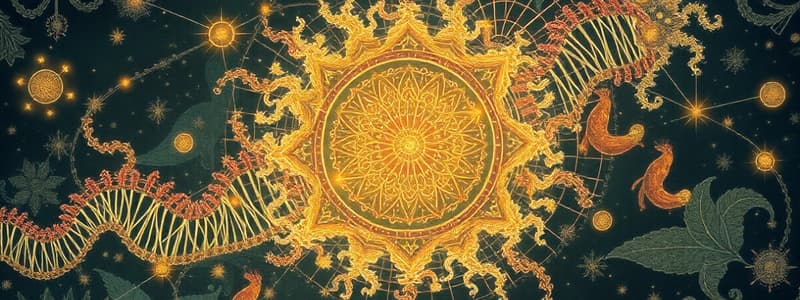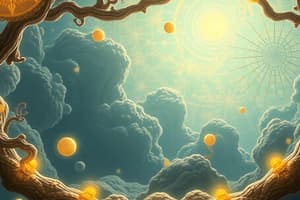Podcast
Questions and Answers
The development of ______ and other protective structures in animals aided the colonization of land.
The development of ______ and other protective structures in animals aided the colonization of land.
exoskeletons
The earliest evidence of life comes from fossilized microbial mats called ______.
The earliest evidence of life comes from fossilized microbial mats called ______.
stromatolites
The first cells are believed to have been ______, lacking a nucleus and other complex organelles.
The first cells are believed to have been ______, lacking a nucleus and other complex organelles.
prokaryotic
The most severe mass extinction event, known as the "Great Dying," occurred during the ______ period.
The most severe mass extinction event, known as the "Great Dying," occurred during the ______ period.
[Blank], four-limbed vertebrates, evolved from lobe-finned fishes and eventually adapted to life on land.
[Blank], four-limbed vertebrates, evolved from lobe-finned fishes and eventually adapted to life on land.
The Cambrian explosion is thought to have been influenced by rising oxygen levels, increased ocean calcium concentrations, and the evolution of ______ genes.
The Cambrian explosion is thought to have been influenced by rising oxygen levels, increased ocean calcium concentrations, and the evolution of ______ genes.
One of the key milestones in early human evolution was the development of ______, which allowed early hominids to see over tall grasses and conserve energy.
One of the key milestones in early human evolution was the development of ______, which allowed early hominids to see over tall grasses and conserve energy.
The ______ extinction event, caused by an asteroid impact, led to the demise of the dinosaurs and the rise of mammals.
The ______ extinction event, caused by an asteroid impact, led to the demise of the dinosaurs and the rise of mammals.
Before the Cambrian explosion, life was mainly characterized by relatively simple, ______-bodied organisms.
Before the Cambrian explosion, life was mainly characterized by relatively simple, ______-bodied organisms.
Flashcards
Chemical Evolution
Chemical Evolution
Simple inorganic molecules gradually formed complex organic molecules.
Protocells Definition
Protocells Definition
Membrane-bound droplets with internal chemistry different from surroundings.
RNA World Hypothesis
RNA World Hypothesis
RNA was the primary genetic material in early life forms.
Prokaryotic Cells
Prokaryotic Cells
Signup and view all the flashcards
Stromatolites
Stromatolites
Signup and view all the flashcards
Oxygenic Photosynthesis
Oxygenic Photosynthesis
Signup and view all the flashcards
Oxygen Revolution
Oxygen Revolution
Signup and view all the flashcards
Eukaryotic Cells Definition
Eukaryotic Cells Definition
Signup and view all the flashcards
Endosymbiosis
Endosymbiosis
Signup and view all the flashcards
Cambrian Explosion
Cambrian Explosion
Signup and view all the flashcards
Hox Genes
Hox Genes
Signup and view all the flashcards
Colonization of Land
Colonization of Land
Signup and view all the flashcards
Mass Extinctions
Mass Extinctions
Signup and view all the flashcards
Permian-Triassic Extinction
Permian-Triassic Extinction
Signup and view all the flashcards
Bipedalism
Bipedalism
Signup and view all the flashcards
Homo sapiens
Homo sapiens
Signup and view all the flashcards
Study Notes
- The history of life on Earth spans billions of years, marked by significant evolutionary events and environmental changes.
Origin of Life
- Earth is about 4.54 billion years old.
- Life is believed to have emerged between 4.0 and 3.5 billion years ago.
- The precise mechanisms of life's origin remain under investigation, with several hypotheses.
- A prevailing hypothesis suggests chemical evolution where inorganic molecules formed complex organic molecules like amino acids and nucleotides.
- Organic molecules may have assembled into polymers like proteins and nucleic acids.
- Protocell formation, membrane-bound droplets with distinct internal chemistry, is a critical step.
- The RNA world hypothesis posits RNA, not DNA, as the primary genetic material in early life.
- RNA can store information and catalyze reactions.
Early Life and the First Cells
- The first cells were likely prokaryotic, lacking a nucleus and complex organelles.
- Early prokaryotes were probably anaerobic, thriving without free oxygen.
- The earliest evidence of life is from fossilized microbial mats called stromatolites.
- Stromatolites date back about 3.5 billion years.
- Early life forms used chemosynthesis for energy, utilizing inorganic compounds like hydrogen sulfide.
Photosynthesis and the Oxygen Revolution
- The evolution of photosynthesis, notably oxygenic photosynthesis by cyanobacteria, was pivotal.
- Oxygenic photosynthesis uses sunlight, water, and CO2 to produce energy, releasing oxygen.
- Oxygen accumulation led to the "oxygen revolution" or "Great Oxidation Event" around 2.4 billion years ago.
- The event led to the extinction of many anaerobic organisms.
- Aerobic respiration, a more efficient energy production method, became possible.
- Increased atmospheric oxygen also led to the formation of the ozone layer.
Eukaryotic Cells
- Eukaryotic cells, featuring a nucleus and membrane-bound organelles, evolved from prokaryotic cells.
- The endosymbiotic theory explains the origin of mitochondria and chloroplasts in eukaryotes.
- These organelles were once free-living prokaryotes engulfed by a host cell.
- Over time, this evolved into a mutually beneficial relationship.
- The oldest eukaryotic fossils are about 1.8 billion years old.
The Cambrian Explosion
- The Cambrian explosion, roughly 540 million years ago, saw a rapid diversification of multicellular life.
- Many major animal phyla appeared, developing various body plans and ecological niches.
- Factors contributing to the Cambrian explosion include rising oxygen, increased ocean calcium, and Hox gene evolution.
- Hox genes are vital in regulating animal development.
- Before the Cambrian explosion, simpler, soft-bodied organisms dominated life.
Colonization of Land
- Life began colonizing land around 500 million years ago.
- Plants were among the first to transition, followed by arthropods and vertebrates.
- Adaptations for terrestrial life included vascular systems in plants.
- Exoskeletons and protective structures in animals aided land colonization.
- Tetrapods, four-limbed vertebrates, evolved from lobe-finned fishes and adapted to land.
Mass Extinctions
- Mass extinctions are events with significant species die-offs in a short time.
- Earth has experienced five major mass extinction events.
- Causes vary but often involve catastrophic events like asteroid impacts, volcanic eruptions, and climate change.
- The Permian-Triassic extinction, the "Great Dying," eliminated about 96% of marine species.
- The Cretaceous-Paleogene extinction, which caused dinosaur extinction, resulted from an asteroid impact.
- Mass extinctions can allow surviving species to diversify.
Evolution of Humans
- Humans are primates.
- The human lineage split from other apes around 6 to 7 million years ago.
- Key milestones include bipedalism, increased brain size, and the development of tools and language.
- The genus Homo appeared about 2.5 million years ago.
- Homo sapiens, modern humans, evolved in Africa around 300,000 years ago.
- Humans have significantly impacted the planet.
- Impacts include altered ecosystems, causing extinctions, and driving climate change.
Studying That Suits You
Use AI to generate personalized quizzes and flashcards to suit your learning preferences.




